





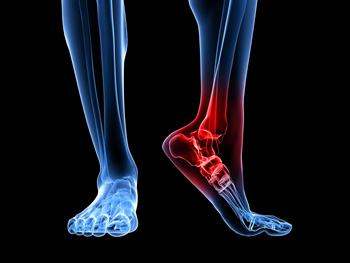 Growing adolescents may experience the medical condition that is known as Sever’s disease. It typically affects teenagers who frequently participate in sporting activities, and pain and discomfort may be felt in the heel during physical activity. Reduced flexibility can be a result of the inflammation that can occur from tightened muscles. Noticeable signs that your child can exhibit include limping, and favoring one foot. The foot may feel better with rest, and when specific stretches are performed and this is most beneficial when done on a daily basis. If your child has heel pain, it is recommended that you consult with a podiatrist who can properly diagnose and treat Sever's disease.
Growing adolescents may experience the medical condition that is known as Sever’s disease. It typically affects teenagers who frequently participate in sporting activities, and pain and discomfort may be felt in the heel during physical activity. Reduced flexibility can be a result of the inflammation that can occur from tightened muscles. Noticeable signs that your child can exhibit include limping, and favoring one foot. The foot may feel better with rest, and when specific stretches are performed and this is most beneficial when done on a daily basis. If your child has heel pain, it is recommended that you consult with a podiatrist who can properly diagnose and treat Sever's disease.
Sever's disease often occurs in children and teens. If your child is experiencing foot or ankle pain, see one of our podiatrists from Active Foot and Ankle Care, LLC. Our doctors can treat your child’s foot and ankle needs.
Sever’s Disease
Sever’s disease is also known as calcaneal apophysitis, which is a medical condition that causes heel pain I none or both feet. The disease is known to affect children between the ages of 8 and 14.
Sever’s disease occurs when part of the child’s heel known as the growth plate (calcaneal epiphysis) is attached to the Achilles tendon. This area can suffer injury when the muscles and tendons of the growing foot do not keep pace with bone growth. Therefore, the constant pain which one experiences at the back of the heel will make the child unable to put any weight on the heel. The child is then forced to walk on their toes.
Symptoms
Acute pain – Pain associated with Sever’s disease is usually felt in the heel when the child engages in physical activity such as walking, jumping and or running.
Highly active – Children who are very active are among the most susceptible in experiencing Sever’s disease, because of the stress and tension placed on their feet.
If you have any questions, please feel free to contact our offices located in Fair Lawn, Riverdale, and Englewood, NJ . We offer the newest diagnostic and treatment technologies for all your foot and ankle injuries.
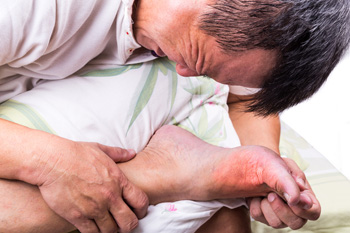 Burning pain in the joints of the big toe is a common symptom that is often associated with gout. This condition can be caused by excess uric acid in the blood levels and crystals can form in the joints. This can lead to severe pain and discomfort, and walking may be difficult. Some of the reasons gout may develop can come from genetic factors, obesity, and eating foods that have high levels of purines. These can include shellfish, red meat, and drinks that are made with large amounts of sugar. Patients who are afflicted with gout may find relief when healthy eating habits are implemented, and it can be beneficial to follow a simple exercise program. People who have gout are strongly advised to be under the care of a podiatrist who can effectively treat this condition.
Burning pain in the joints of the big toe is a common symptom that is often associated with gout. This condition can be caused by excess uric acid in the blood levels and crystals can form in the joints. This can lead to severe pain and discomfort, and walking may be difficult. Some of the reasons gout may develop can come from genetic factors, obesity, and eating foods that have high levels of purines. These can include shellfish, red meat, and drinks that are made with large amounts of sugar. Patients who are afflicted with gout may find relief when healthy eating habits are implemented, and it can be beneficial to follow a simple exercise program. People who have gout are strongly advised to be under the care of a podiatrist who can effectively treat this condition.
Gout is a painful condition that can be treated. If you are seeking treatment, contact one of our podiatrists from Active Foot and Ankle Care, LLC. Our doctors will treat your foot and ankle needs.
What Is Gout?
Gout is a form of arthritis that is characterized by sudden, severe attacks of pain, redness, and tenderness in the joints. The condition usually affects the joint at the base of the big toe. A gout attack can occur at any random time, such as the middle of the night while you are asleep.
Symptoms
Risk Factors
Prior to visiting your podiatrist to receive treatment for gout, there are a few things you should do beforehand. If you have gout you should write down your symptoms--including when they started and how often you experience them, important medical information you may have, and any questions you may have. Writing down these three things will help your podiatrist in assessing your specific situation so that he or she may provide the best route of treatment for you.
If you have any questions, please feel free to contact our offices located in Fair Lawn and Riverdale, New Jersey. We offer the newest diagnostic and treatment technologies for all your foot care needs.
Read more about Gout Burning pain in the joints of the big toe is a common symptom that is often associated with gout. This condition can be caused by excess uric acid in the blood levels and crystals can form in the joints. This can lead to severe pain and discomfort, and walking may be difficult. Some of the reasons gout may develop can come from genetic factors, obesity, and eating foods that have high levels of purines. These can include shellfish, red meat, and drinks that are made with large amounts of sugar. Patients who are afflicted with gout may find relief when healthy eating habits are implemented, and it can be beneficial to follow a simple exercise program. People who have gout are strongly advised to be under the care of a podiatrist who can effectively treat this condition.
Burning pain in the joints of the big toe is a common symptom that is often associated with gout. This condition can be caused by excess uric acid in the blood levels and crystals can form in the joints. This can lead to severe pain and discomfort, and walking may be difficult. Some of the reasons gout may develop can come from genetic factors, obesity, and eating foods that have high levels of purines. These can include shellfish, red meat, and drinks that are made with large amounts of sugar. Patients who are afflicted with gout may find relief when healthy eating habits are implemented, and it can be beneficial to follow a simple exercise program. People who have gout are strongly advised to be under the care of a podiatrist who can effectively treat this condition.
Gout is a painful condition that can be treated. If you are seeking treatment, contact one of our podiatrists from Active Foot and Ankle Care, LLC. Our doctors will treat your foot and ankle needs.
What Is Gout?
Gout is a form of arthritis that is characterized by sudden, severe attacks of pain, redness, and tenderness in the joints. The condition usually affects the joint at the base of the big toe. A gout attack can occur at any random time, such as the middle of the night while you are asleep.
Symptoms
Risk Factors
Prior to visiting your podiatrist to receive treatment for gout, there are a few things you should do beforehand. If you have gout you should write down your symptoms--including when they started and how often you experience them, important medical information you may have, and any questions you may have. Writing down these three things will help your podiatrist in assessing your specific situation so that he or she may provide the best route of treatment for you.
If you have any questions, please feel free to contact our offices located in Fair Lawn, Riverdale, and Englewood, NJ . We offer the newest diagnostic and treatment technologies for all your foot care needs.
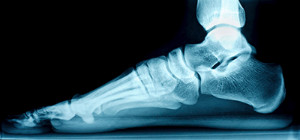 If your feet are lacking the typical arch, you most likely have a condition known as flat feet. There are different types of flat feet that can affect a person. Flexible flat foot, one of the most common types of flat feet, is characterized by lacking an arch only when pressure is applied. When pressure isn’t applied, a flexible flat foot will have an arch, which disappears while standing. Semi-flexible flat feet will have slight to no arch with or without pressure, and then flatten out once standing. A rigid flat foot will have no sign of an arch whether standing or not. To properly diagnose which type of flat feet you have, please consult with a podiatrist.
If your feet are lacking the typical arch, you most likely have a condition known as flat feet. There are different types of flat feet that can affect a person. Flexible flat foot, one of the most common types of flat feet, is characterized by lacking an arch only when pressure is applied. When pressure isn’t applied, a flexible flat foot will have an arch, which disappears while standing. Semi-flexible flat feet will have slight to no arch with or without pressure, and then flatten out once standing. A rigid flat foot will have no sign of an arch whether standing or not. To properly diagnose which type of flat feet you have, please consult with a podiatrist.
Flatfoot is a condition many people suffer from. If you have flat feet, contact one of our podiatrists from Active Foot and Ankle Care, LLC. Our doctors will treat your foot and ankle needs.
What Are Flat Feet?
Flatfoot is a condition in which the arch of the foot is depressed and the sole of the foot is almost completely in contact with the ground. About 20-30% of the population generally has flat feet because their arches never formed during growth.
Conditions & Problems:
Having flat feet makes it difficult to run or walk because of the stress placed on the ankles.
Alignment – The general alignment of your legs can be disrupted, because the ankles move inward which can cause major discomfort.
Knees – If you have complications with your knees, flat feet can be a contributor to arthritis in that area.
Symptoms
Treatment
If you are experiencing pain and stress on the foot you may weaken the posterior tibial tendon, which runs around the inside of the ankle.
If you have any questions please feel free to contact our offices located in Fair Lawn and Riverdale, New Jersey. We offer the newest diagnostic and treatment technologies for all your foot and ankle needs.
Read more about Flatfoot If your feet are lacking the typical arch, you most likely have a condition known as flat feet. There are different types of flat feet that can affect a person. Flexible flat foot, one of the most common types of flat feet, is characterized by lacking an arch only when pressure is applied. When pressure isn’t applied, a flexible flat foot will have an arch, which disappears while standing. Semi-flexible flat feet will have slight to no arch with or without pressure, and then flatten out once standing. A rigid flat foot will have no sign of an arch whether standing or not. To properly diagnose which type of flat feet you have, please consult with a podiatrist.
If your feet are lacking the typical arch, you most likely have a condition known as flat feet. There are different types of flat feet that can affect a person. Flexible flat foot, one of the most common types of flat feet, is characterized by lacking an arch only when pressure is applied. When pressure isn’t applied, a flexible flat foot will have an arch, which disappears while standing. Semi-flexible flat feet will have slight to no arch with or without pressure, and then flatten out once standing. A rigid flat foot will have no sign of an arch whether standing or not. To properly diagnose which type of flat feet you have, please consult with a podiatrist.
Flatfoot is a condition many people suffer from. If you have flat feet, contact one of our podiatrists from Active Foot and Ankle Care, LLC. Our doctors will treat your foot and ankle needs.
What Are Flat Feet?
Flatfoot is a condition in which the arch of the foot is depressed and the sole of the foot is almost completely in contact with the ground. About 20-30% of the population generally has flat feet because their arches never formed during growth.
Conditions & Problems:
Having flat feet makes it difficult to run or walk because of the stress placed on the ankles.
Alignment – The general alignment of your legs can be disrupted, because the ankles move inward which can cause major discomfort.
Knees – If you have complications with your knees, flat feet can be a contributor to arthritis in that area.
Symptoms
Treatment
If you are experiencing pain and stress on the foot you may weaken the posterior tibial tendon, which runs around the inside of the ankle.
If you have any questions please feel free to contact our offices located in Fair Lawn, Riverdale, and Englewood, NJ . We offer the newest diagnostic and treatment technologies for all your foot and ankle needs.
Read more about Flatfoot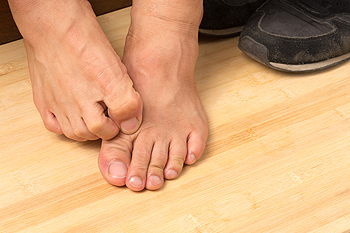 Dry, cracked skin between your toes can be caused by athlete’s foot, a fungal infection of the skin, also known as tinea pedis. Athlete’s foot is an extremely common condition, affecting millions of people each year. When you have athlete’s foot, the skin between your toes may become itchy, flaky, thickened, white, or swollen. This condition can also cause skin redness and pain in your feet. The most common treatment for athlete’s foot is a topical antifungal medication that kills or prevents the growth of the fungus. If you suspect that you have athlete’s foot, it is recommended that you see a podiatrist for a diagnosis and treatment.
Dry, cracked skin between your toes can be caused by athlete’s foot, a fungal infection of the skin, also known as tinea pedis. Athlete’s foot is an extremely common condition, affecting millions of people each year. When you have athlete’s foot, the skin between your toes may become itchy, flaky, thickened, white, or swollen. This condition can also cause skin redness and pain in your feet. The most common treatment for athlete’s foot is a topical antifungal medication that kills or prevents the growth of the fungus. If you suspect that you have athlete’s foot, it is recommended that you see a podiatrist for a diagnosis and treatment.
Athlete’s foot is an inconvenient condition that can be easily reduced with the proper treatment. If you have any concerns about your feet and ankles, contact one of our podiatrists from Active Foot and Ankle Care, LLC. Our doctors will treat your foot and ankle needs.
Athlete’s Foot: The Sole Story
Athlete's foot, also known as tinea pedis, can be an extremely contagious foot infection. It is commonly contracted in public changing areas and bathrooms, dormitory style living quarters, around locker rooms and public swimming pools, or anywhere your feet often come into contact with other people.
Solutions to Combat Athlete’s Foot
Athlete’s foot can cause many irritating symptoms such as dry and flaking skin, itching, and redness. Some more severe symptoms can include bleeding and cracked skin, intense itching and burning, and even pain when walking. In the worst cases, Athlete’s foot can cause blistering as well. Speak to your podiatrist for a better understanding of the different causes of Athlete’s foot, as well as help in determining which treatment options are best for you.
If you have any questions please feel free to contact our offices located in Fair Lawn and Riverdale, New Jersey. We offer the newest diagnostic and treatment technologies for all your foot and ankle needs.
Read more about Athlete's Foot Dry, cracked skin between your toes can be caused by athlete’s foot, a fungal infection of the skin, also known as tinea pedis. Athlete’s foot is an extremely common condition, affecting millions of people each year. When you have athlete’s foot, the skin between your toes may become itchy, flaky, thickened, white, or swollen. This condition can also cause skin redness and pain in your feet. The most common treatment for athlete’s foot is a topical antifungal medication that kills or prevents the growth of the fungus. If you suspect that you have athlete’s foot, it is recommended that you see a podiatrist for a diagnosis and treatment.
Dry, cracked skin between your toes can be caused by athlete’s foot, a fungal infection of the skin, also known as tinea pedis. Athlete’s foot is an extremely common condition, affecting millions of people each year. When you have athlete’s foot, the skin between your toes may become itchy, flaky, thickened, white, or swollen. This condition can also cause skin redness and pain in your feet. The most common treatment for athlete’s foot is a topical antifungal medication that kills or prevents the growth of the fungus. If you suspect that you have athlete’s foot, it is recommended that you see a podiatrist for a diagnosis and treatment.
Athlete’s foot is an inconvenient condition that can be easily reduced with the proper treatment. If you have any concerns about your feet and ankles, contact one of our podiatrists from Active Foot and Ankle Care, LLC. Our doctors will treat your foot and ankle needs.
Athlete’s Foot: The Sole Story
Athlete's foot, also known as tinea pedis, can be an extremely contagious foot infection. It is commonly contracted in public changing areas and bathrooms, dormitory style living quarters, around locker rooms and public swimming pools, or anywhere your feet often come into contact with other people.
Solutions to Combat Athlete’s Foot
Athlete’s foot can cause many irritating symptoms such as dry and flaking skin, itching, and redness. Some more severe symptoms can include bleeding and cracked skin, intense itching and burning, and even pain when walking. In the worst cases, Athlete’s foot can cause blistering as well. Speak to your podiatrist for a better understanding of the different causes of Athlete’s foot, as well as help in determining which treatment options are best for you.
If you have any questions please feel free to contact our offices located in Fair Lawn, Riverdale, and Englewood, NJ . We offer the newest diagnostic and treatment technologies for all your foot and ankle needs.
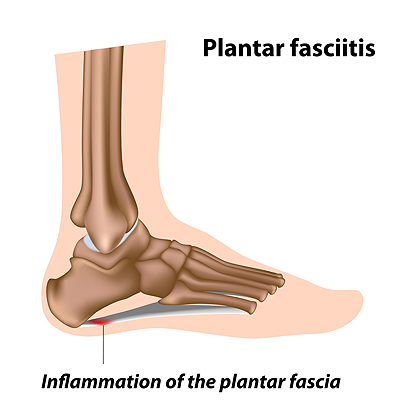 The medical condition that is referred to as plantar fasciitis occurs when the plantar fascia becomes inflamed. The plantar fascia is the portion of tissue that is located on the bottom of the foot, and connects the heel to the toes. Inflammation in the heel can occur as a result of standing on hard surfaces for the majority of the day, or from wearing shoes that do not fit correctly. Additionally, plantar fasciitis may gradually develop from being overweight. Professional baseball players may frequently experience this condition, and it is often caused by excessive running. Moderate relief may be found by resting and elevating the affected foot, and surgery may be required if the pain is severe. If you are suffering from this debilitating condition, it is suggested that you consult with a podiatrist as quickly as possible so that the correct treatment can begin.
The medical condition that is referred to as plantar fasciitis occurs when the plantar fascia becomes inflamed. The plantar fascia is the portion of tissue that is located on the bottom of the foot, and connects the heel to the toes. Inflammation in the heel can occur as a result of standing on hard surfaces for the majority of the day, or from wearing shoes that do not fit correctly. Additionally, plantar fasciitis may gradually develop from being overweight. Professional baseball players may frequently experience this condition, and it is often caused by excessive running. Moderate relief may be found by resting and elevating the affected foot, and surgery may be required if the pain is severe. If you are suffering from this debilitating condition, it is suggested that you consult with a podiatrist as quickly as possible so that the correct treatment can begin.
Plantar fasciitis is a common foot condition that is often caused by a strain injury. If you are experiencing heel pain or symptoms of plantar fasciitis, contact one of our podiatrists from Active Foot and Ankle Care, LLC. Our doctors can provide the care you need to keep you pain-free and on your feet.
What Is Plantar Fasciitis?
Plantar fasciitis is one of the most common causes of heel pain. The plantar fascia is a ligament that connects your heel to the front of your foot. When this ligament becomes inflamed, plantar fasciitis is the result. If you have plantar fasciitis you will have a stabbing pain that usually occurs with your first steps in the morning. As the day progresses and you walk around more, this pain will start to disappear, but it will return after long periods of standing or sitting.
What Causes Plantar Fasciitis?
There are some risk factors that may make you more likely to develop plantar fasciitis compared to others. The condition most commonly affects adults between the ages of 40 and 60. It also tends to affect people who are obese because the extra pounds result in extra stress being placed on the plantar fascia.
Prevention
There are a variety of treatment options available for plantar fasciitis along with the pain that accompanies it. Additionally, physical therapy is a very important component in the treatment process. It is important that you meet with your podiatrist to determine which treatment option is best for you.
If you have any questions, please feel free to contact our offices located in Fair Lawn and Riverdale, New Jersey. We offer the newest diagnostic and treatment technologies for all your foot care needs.
Read more about Plantar Fasciitis
 The medical condition that is referred to as plantar fasciitis occurs when the plantar fascia becomes inflamed. The plantar fascia is the portion of tissue that is located on the bottom of the foot, and connects the heel to the toes. Inflammation in the heel can occur as a result of standing on hard surfaces for the majority of the day, or from wearing shoes that do not fit correctly. Additionally, plantar fasciitis may gradually develop from being overweight. Professional baseball players may frequently experience this condition, and it is often caused by excessive running. Moderate relief may be found by resting and elevating the affected foot, and surgery may be required if the pain is severe. If you are suffering from this debilitating condition, it is suggested that you consult with a podiatrist as quickly as possible so that the correct treatment can begin.
The medical condition that is referred to as plantar fasciitis occurs when the plantar fascia becomes inflamed. The plantar fascia is the portion of tissue that is located on the bottom of the foot, and connects the heel to the toes. Inflammation in the heel can occur as a result of standing on hard surfaces for the majority of the day, or from wearing shoes that do not fit correctly. Additionally, plantar fasciitis may gradually develop from being overweight. Professional baseball players may frequently experience this condition, and it is often caused by excessive running. Moderate relief may be found by resting and elevating the affected foot, and surgery may be required if the pain is severe. If you are suffering from this debilitating condition, it is suggested that you consult with a podiatrist as quickly as possible so that the correct treatment can begin.
Plantar fasciitis is a common foot condition that is often caused by a strain injury. If you are experiencing heel pain or symptoms of plantar fasciitis, contact one of our podiatrists from Active Foot and Ankle Care, LLC. Our doctors can provide the care you need to keep you pain-free and on your feet.
What Is Plantar Fasciitis?
Plantar fasciitis is one of the most common causes of heel pain. The plantar fascia is a ligament that connects your heel to the front of your foot. When this ligament becomes inflamed, plantar fasciitis is the result. If you have plantar fasciitis you will have a stabbing pain that usually occurs with your first steps in the morning. As the day progresses and you walk around more, this pain will start to disappear, but it will return after long periods of standing or sitting.
What Causes Plantar Fasciitis?
There are some risk factors that may make you more likely to develop plantar fasciitis compared to others. The condition most commonly affects adults between the ages of 40 and 60. It also tends to affect people who are obese because the extra pounds result in extra stress being placed on the plantar fascia.
Prevention
There are a variety of treatment options available for plantar fasciitis along with the pain that accompanies it. Additionally, physical therapy is a very important component in the treatment process. It is important that you meet with your podiatrist to determine which treatment option is best for you.
If you have any questions, please feel free to contact our offices located in Fair Lawn, Riverdale, and Englewood, NJ . We offer the newest diagnostic and treatment technologies for all your foot care needs.
Read more about Plantar Fasciitis
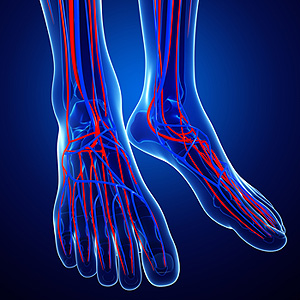 Poor circulation refers to inadequate blood flow to a part of the body. Poor circulation to the legs and feet is particularly concerning as it can lead to serious medical complications, in severe cases this could include amputation. The most common symptoms of poor circulation are numbness and tingling in the feet, cold feet, swelling in the feet, ankles, or legs, skin color changes, and foot ulcers. Poor circulation is typically caused by plaque buildup in the blood vessels. The plaque hardens and narrows the blood vessels, restricting blood flow to the affected areas. When those affected areas are the lower limbs, this is known as peripheral artery disease or PAD. A podiatrist can screen for this condition during a routine visit. If you experience poor circulation to the lower limbs, it is suggested that you consult with a podiatrist today.
Poor circulation refers to inadequate blood flow to a part of the body. Poor circulation to the legs and feet is particularly concerning as it can lead to serious medical complications, in severe cases this could include amputation. The most common symptoms of poor circulation are numbness and tingling in the feet, cold feet, swelling in the feet, ankles, or legs, skin color changes, and foot ulcers. Poor circulation is typically caused by plaque buildup in the blood vessels. The plaque hardens and narrows the blood vessels, restricting blood flow to the affected areas. When those affected areas are the lower limbs, this is known as peripheral artery disease or PAD. A podiatrist can screen for this condition during a routine visit. If you experience poor circulation to the lower limbs, it is suggested that you consult with a podiatrist today.
Poor circulation is a serious condition and needs immediate medical attention. If you have any concerns with poor circulation in your feet contact one of our podiatrists of Active Foot and Ankle Care, LLC. Our doctors will treat your foot and ankle needs.
Poor Circulation in the Feet
Poor blood circulation in the feet and legs is can be caused by peripheral artery disease (PAD), which is the result of a buildup of plaque in the arteries.
Plaque buildup or atherosclerosis results from excess calcium and cholesterol in the bloodstream. This can restrict the amount of blood which can flow through the arteries. Poor blood circulation in the feet and legs are sometimes caused by inflammation in the blood vessels, known as vasculitis.
Causes
Lack of oxygen and oxygen from poor blood circulation restricts muscle growth and development. It can also cause:
Those who have diabetes or smoke are at greatest risk for poor circulation, as are those who are over 50. If you have poor circulation in the feet and legs it may be caused by PAD and is important to make changes to your lifestyle in order to reduce risk of getting a heart attack or stroke. Exercise and maintaining a healthy lifestyle will dramatically improve conditions.
As always, see a podiatrist as he or she will assist in finding a regimen that suits you. A podiatrist can also prescribe you any needed medication.
If you have any questions please feel free to contact our offices located in Fair Lawn and Riverdale, New Jersey. We offer the newest diagnostic and treatment technologies for all your foot and ankle needs.
Read more about Causes, Symptoms, and Treatment of Poor Blood Circulation in the Feet





